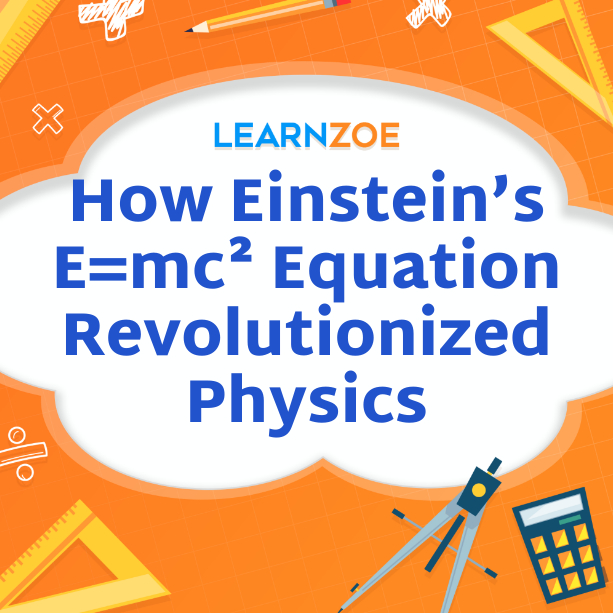How Einstein’s E=mc² Equation Revolutionized Physics

Introduction to Albert Einstein and his theory of relativity
Albert Einstein is one of the most iconic figures in the field of physics. His groundbreaking theory of relativity revolutionized our understanding of space, time, and the relationship between mass and energy. Born in Germany in 1879, Einstein was a brilliant and curious person from a young age. He developed the theory of relativity in 1905 and 1915, which became the foundation for modern physics. His famous equation, E=mc², is synonymous with his name and represents the equivalence of mass and energy. Einstein’s theories continue to shape our understanding of the universe.
Significance of E=mc² in the field of physics
E=mc² is an incredibly significant equation in the field of physics. It revolutionized our understanding of energy and mass. With this equation, you can convert mass into energy and vice versa. It opened up new possibilities for scientific exploration and technological advancements. The equation is a fundamental principle in nuclear physics and helps us comprehend the immense energy released during nuclear reactions. E=mc² has paved the way for advancements in nuclear energy, weaponry, and space travel. Its significance cannot be overstated as it continues to shape our understanding of the universe.
Mass-Energy Equivalence
The concept of mass-energy equivalence is a fundamental idea in physics. It suggests that mass and energy are interchangeable and can be converted into one another. It means that even a small amount of mass can contain a lot of energy. Einstein’s equation, E=mc², quantifies this relationship. It states that energy (E) is equal to the mass (m) multiplied by the square of the speed of light (c). This equation revolutionized our understanding of the universe by revealing the profound connection between mass and energy.
Explanation of the concept of mass-energy equivalence
Mass-energy equivalence is the idea that mass and energy can be converted into one another. It means that even a tiny mass can hold tremendous energy. Albert Einstein introduced this concept in his theory of relativity. It reveals that mass and energy are two different forms of the same thing and can transform from one to the other. This revolutionary concept has transformed our understanding of the universe and has had profound implications in the field of physics.
Derivation of the E=mc² equation
The derivation of the E=mc² equation starts with Einstein’s theory of relativity. In this theory, he proposed that the laws of physics are the same in all inertial reference frames. It means that the speed of light is constant no matter how fast an observer moves. Using this as a foundation, Einstein combined the principles of energy and mass to derive the famous equation. He showed that the energy (E) of an object is equal to its mass (m) multiplied by the speed of light (c) squared. This equation revolutionized our understanding of the relationship between mass and energy.
Speed of Light and Energy Equivalence
Understanding the constant speed of light in E=mc²
Now, let’s dive deeper into the speed of light and its relationship to energy equivalence. In the equation E=mc², the “c²” represents the speed of light squared. The speed of light in a vacuum is approximately 299,792,458 meters per second.
This constant value of the speed of light is crucial in the equation because it shows that a small amount of mass can be converted into an enormous amount of energy. The speed of light is so incredibly fast that the conversion factor, when squared, amplifies the energy released from a mass-energy conversion.
So, the equation E=mc² tells us that even a tiny mass can unleash a tremendous amount of energy due to the immense speed of light. This concept has significant implications in various fields, including nuclear physics and energy production.
Impact on Nuclear Physics
E=mc² has had a profound impact on the field of nuclear physics. It helps us understand the reductions in mass and the enormous releases of energy that occur in nuclear fission and fusion processes. By focusing on the mass per nucleon in the atomic nucleus rather than the mass of the nucleus itself, we can better comprehend the energy transformations involved. This equation has provided a foundation for research and experimentation in nuclear reactions, paving the way for advancements in nuclear energy and weaponry. E=mc² continues to play a crucial role in our understanding of the atomic world.
E=mc² and its role in nuclear reactions
E=mc² plays a crucial role in understanding nuclear reactions. It helps you comprehend the relationship between mass and energy in these reactions. The equation shows how a small mass can be converted into a large amount of energy. It is what happens in nuclear fission and fusion processes. E=mc² explains the enormous energy releases and mass reductions during these reactions. It has provided the basis for advancements in nuclear energy and weaponry. In essence, E=mc² is the key to understanding the immense power of nuclear reactions.
Conclusion
In conclusion, Albert Einstein’s equation E=mc² has revolutionized physics and our understanding of the relationship between energy and mass. It has shown that these two seemingly distinct entities are interconnected, opening up new possibilities and insights in science. This equation has paved the way for advancements in nuclear energy and weaponry, shaping the course of energy production and military capabilities. The implications of E=mc² have transformed our understanding of the universe and profoundly impacted various aspects of human life.
